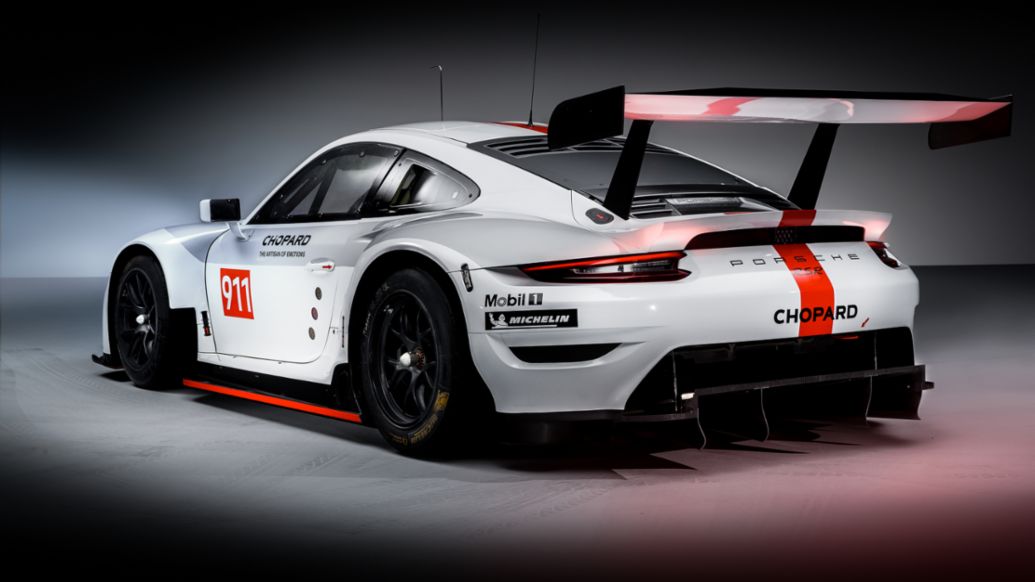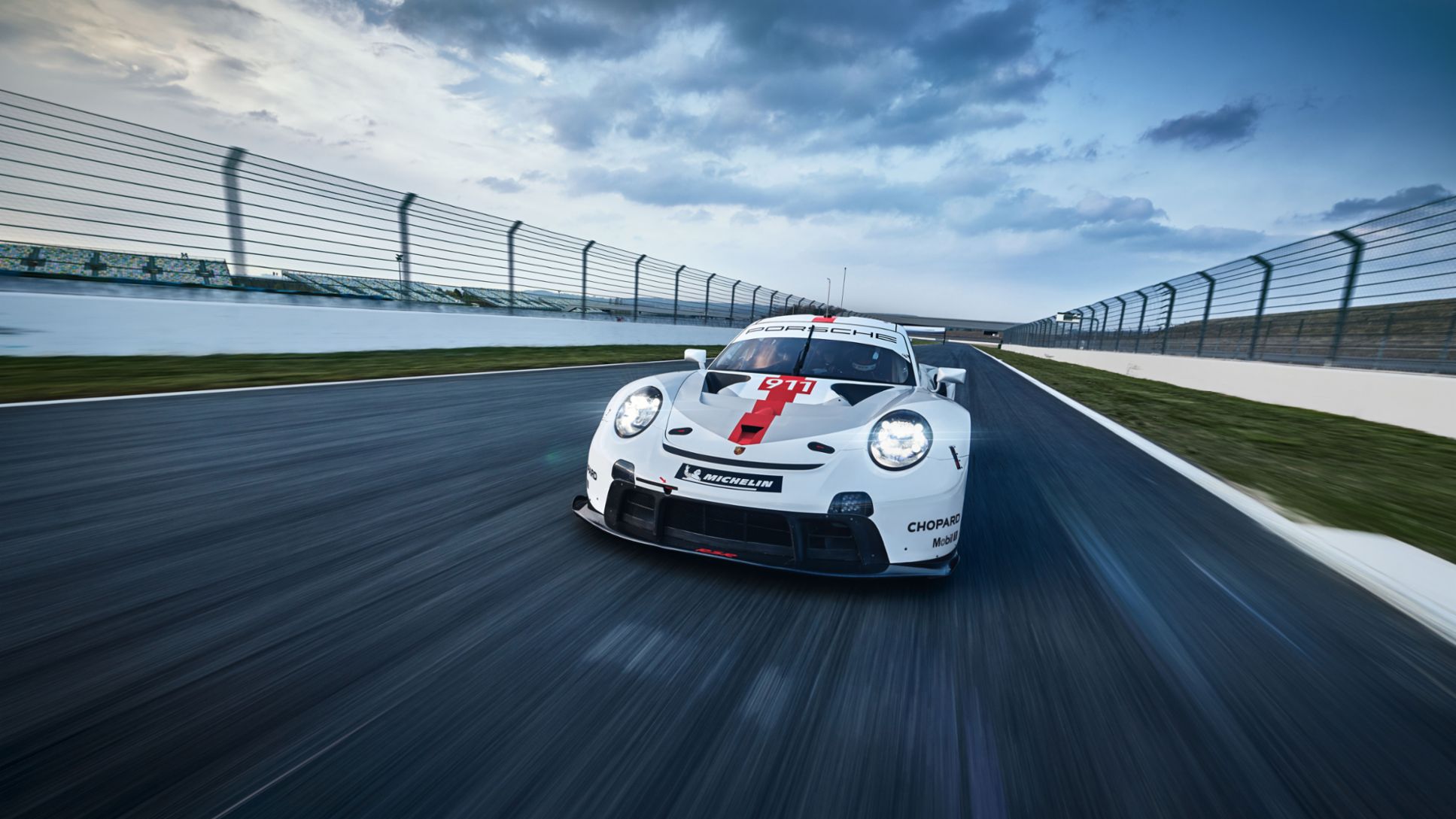Porsche puts its faith in the brand-new 911 RSR (2019 model year) to defend the FIA World Endurance Championship (WEC) title. The vehicle from Weissach has undergone improvements in all areas and replaces the successful 911 RSR with which Porsche won the manufacturers’ and drivers’ world championship in the FIA WEC as well as the Le Mans endurance classic (France) and the IMSA races at Sebring and Road Atlanta (Petit Le Mans) amongst other events in 2019.
The race car complying with the FIA GTE regulations is a completely new development. The considerable experiences amassed by the factory and customer teams from successful race outings around the world have been incorporated. The engineers at Weissach analysed all race campaigns with the Porsche 911 RSR and implemented improvements, especially in the areas of driveability, efficiency, durability and serviceability.
By repositioning the tailpipes to the front of the rear wheels, space was made for an optimised rear diffuser of the Porsche 911 RSR. Thanks to the optimisation of airflow at the front and the sides of the new Weissach racer, aerodynamic efficiency and stability increased significantly, thereby further improving the function and durability of the tyres during racing.
New flat engine with larger displacement
Like its predecessor, the new 911 RSR is powered by a six-cylinder naturally aspirated engine. The new power unit is the largest ever boxer engine to be mounted in a Porsche 911 ex-works. With a capacity of 4,194 cc, the highly efficient flat engine, which is positioned in front of the rear axle, puts out ca. 515 hp depending on the BoP rating. Power is delivered to the rear wheels via a weight-optimised, more rigid sequential six-speed constant-mesh gearbox. Thanks to a wider rev-band, the new engine offers even better driveability compared to the predecessor’s proven four-litre aggregate. The new powertrain in the Porsche 911 RSR offers faster gear-shift times and increased efficiency.
Focus on drivers and mechanics
Driveability and serviceability are critical factors in long-distance racing. For this reason, Porsche placed particular emphasis on these aspects when developing the new 911 RSR. The cockpit has been reworked with the focus on better usability, with the help of extensive feedback from the Porsche drivers. Like with the predecessor, the body elements made of carbon-fibre reinforced plastic can be swapped out quickly and thus ensures efficient pit processes in long-distance racing.
To give drivers added protection, the active and passive safety elements in the Porsche 911 RSR have been further optimised. The collision warning system allows drivers an even better overview to detect approaching prototype vehicles early enough. The optimised roll cage, the FIA side-impact panel between the door and cage as well as additional impact protection for the legs improve the passive safety in the event of an accident. Other features include the removable roof hatch and the rigidly-mounted racing seat.
Two different liveries
The factory race cars from Weissach sport two different designs: The typical Porsche white continues to be the dominating colour on the No. 91 car. Added accents include a centrally-placed red stripe extending from the front hood over the roof to the rear apron, as well as red side sills. Grey highlights on the side complement the clear and dynamic design. On the No. 92 car, the white and grey colours are reversed. The rear wing and the wing mirrors are black instead of white so that fans can differentiate between the two.

Technical data Porsche 911 RSR model year 2019
Concept
Single-seater race car for the FIA GTE category (USA: GTLM)
Engine
Water-cooled six-cylinder boxer, positions in front of the rear axle; capacity 4,194 cc, stroke 81.5 mm, bore 104.5 mm; ca. 378 kW (515 hp) depending of restrictor; 4-valve technology; direct fuel injection; dry sump lubrication; single mass flywheel; power output limitation via restrictor; electronic throttle; side-exit exhaust system.
Transmission
Weight-optimised six-speed sequential constant-mesh gearbox; two-shaft longitudinal layout with bevel gear; shifting via electronic shift actuator; shift paddles on the steering wheel; magnesium gearbox casing; multi-disc self-locking differential with visco unit; three disc carbon race clutch.
Body
Weight-optimised bodyshell in aluminium-steel composite design; removable roof hatch; T3 fuel cell in front of the car; welded-in roll cage; seat pursuant to FIA 8862-2009; rigidly mounted to the chassis; six-point safety harness for use with HANS®; longitudinally adjustable pedalry; aerodynamically-optimised and quick-release body components made of CFRP; rear wing with “swan neck” mounts; four-post air jack system with safety pressure valve; electronically activated fire extinguisher system; heated windscreen.
Suspension
Front axle
Double wishbone front axle; four-way vibration damper; with coil spring setup; anti-roll bars, adjustable by blade position; electro-hydraulic power steering.
Rear axle
Integrated rear-axle subframe with double wishbone axle; four-way vibration damper; with coil spring setup; anti-roll bars, adjustable by blade positions; electro-hydraulic power steering; tripod drive shafts.
Brakes
Two independent brake circuits for front and rear axle, adjustable via balance bar.
Front axle
One piece aluminium six-piston racing callipers with quick release coupling; internally ventilated steel brake discs, 390 mm diameter; race brake pads; optimised brake cooling ducts.
Rear axle
One piece aluminium four-piston racing callipers with quick release coupling; internally ventilated steel brake discs, 355 mm diameter; race brake pads; optimised brake cooling ducts.
Wheels / tyres
Front axle
One piece forged light alloy wheels, 12.5Jx18 offset 25 with centre lock nut and wheel nuts; Michelin slick 30/68-18.
Rear axle
One piece forged light alloy wheels, 13Jx18 offset 37 with centre lock nut and wheel nuts; Michelin slick 31/71-18.
Electrics
Cosworth Central Logger Unit; CFRP multi-functional steering wheel with integrated display; shift paddles and quick release; Collision Avoidance System; controlled alternator in connection with LiFePo4 battery; LED headlights; LED taillights plus rain light; illuminated car number and leader light system; black light inside cockpit; electric adjustable wing mirrors with memory function; tyre pressure monitoring system (TPMS); drink system; air conditioning system; membrane switch panel on centre console with fluorescent labelling.
Weight / dimensions
Base weight: ca. 1,245 kg, length: 4,593 mm (without splitter, rear wing, diffuser), width: 2,042 mm (front axle) / 2,050 mm (rear axle), wheelbase: 2,513 mm.




